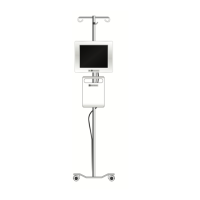7-2
Methodology and Monitoring
Single Cuff Monitoring
A single ClearSight Finger Cuff can be used for accumulated
monitoring in the same patient for up to 8 hours. During
single cuff monitoring, the EV1000 Noninvasive System will
automatically release the pressure in the cuff at regular
intervals. See “Cuff Pressure Release Mode” on page 7-9.
After 8 hours of accumulated monitoring on the same
finger, the EV1000 Noninvasive System will stop monitoring
and display a warning to place the cuff on another finger if
continued monitoring is desired.
Double Cuff Monitoring
For monitoring periods lasting longer than 8 hours, the
EV1000 Clinical Platform NI enables two ClearSight Finger
Cuffs to be connected simultaneously on separate fingers. In
this configuration, the system switches active monitoring
between the two cuffs at a user selected interval to allow for
uninterrupted continuous monitoring. See “Cuff Options” on
page 7-8.
When using the double cuff configuration, ensure that
each finger is sized separately. It is not uncommon for
patients to have two different sized fingers requiring two
different sized ClearSight Finger Cuffs. Failure to select the
correct finger cuff can result in measurement inaccuracy.
Upon starting a measurement, the Finger Cuff will expire
after 72 hours for a single patient.
Peñáz J (1973), “Photoelectric measurement of blood pressure,
volume and flow in the finger,” Digest of the 10th Int Conf Med
Biol Engng, Dresden, p. 104.
Wesseling KH, et al. (1995), “Physiocal, calibration finger vascular
physiology for Finapres,” Homeostasis 36 (2-3), pp. 67-82.
Gizdulich P, Prentza A, Wesseling KH (1997), “Models of brachial
to finger pulse wave distortion and pressure decrement,” Cardiovas-
cular Research 33 (3), pp. 698-705.
Connect the Patient Sensors
Proper application of the Pressure Controller, Heart
Reference Sensor and ClearSight Finger Cuff(s) is necessary
for accurate monitoring when using the EV1000 Clinical
Platform NI. The Heart Reference Sensor must be zeroed
before being attached to the patient
.
WARNING
Do not sterilize any components of the EV1000
Noninvasive System. The EV1000 Noninvasive System
is provided non sterile.
WARNING
Refer to cleaning instructions. Do not disinfect the
instrument by autoclave or gas sterilization.
WARNING
Refer to the directions provided with each accessory for
specific instructions on placement and use, and for
relevant WARNINGS, CAUTIONS, and specifications.
WARNING
Do not use damaged components/sensors or
components/sensors with exposed electrical contacts to
prevent patient or user shocks.
WARNING
The EV1000 Noninvasive System monitoring
components are not defibrillation proof. Disconnect the
system before defibrillating.
WARNING
Do not touch the system connectors of the EV1000
Clinical Platform NI and the patient at the same time.
WARNING
Only use ClearSight Finger Cuffs, Heart Reference
Sensor and other EV1000 Noninvasive System
accessories, cables and or components that have been
supplied and labeled by Edwards. Using other
unlabeled accessories, cables and or components may
affect patient safety and measurement accuracy.
WARNING
Always remove EV1000 Noninvasive System sensors
and components from the patient and completely
disconnect the patient from the instrument before
bathing the patient.
CAUTION
The effectiveness of EV1000 Noninvasive System has
not been evaluated in patients under 18 years of age.
CAUTION
Always grasp the connector, not the cable, when
connecting or disconnecting cables. Do not twist or
bend the connectors. Confirm that all sensors and
cables are connected correctly and completely before
use.

